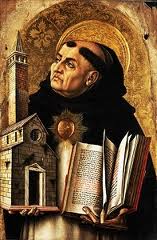 The Summa Theologica (Latin: Compendium of Theology or Theological Compendium; also subsequently called the Summa Theologica or simply the Summa, written 1265–1274) is the best-known work of Thomas Aquinas (c.1225–1274), and although unfinished, “one of the classics of the history of philosophy and one of the most influential works of Western literature.” It is intended as a manual for beginners in theology and a compendium of all of the main theological teachings of the Church. It presents the reasoning for almost all points of Christian theology in the West. The Summa’s topics follow a cycle: the existence of God; Creation, Man; Man’s purpose; Christ; the Sacraments; and back to God. The Summa Theologica (Latin: Compendium of Theology or Theological Compendium; also subsequently called the Summa Theologica or simply the Summa, written 1265–1274) is the best-known work of Thomas Aquinas (c.1225–1274), and although unfinished, “one of the classics of the history of philosophy and one of the most influential works of Western literature.” It is intended as a manual for beginners in theology and a compendium of all of the main theological teachings of the Church. It presents the reasoning for almost all points of Christian theology in the West. The Summa’s topics follow a cycle: the existence of God; Creation, Man; Man’s purpose; Christ; the Sacraments; and back to God.
It is famous, among other things, for its five arguments for the existence of God, the Quinque viae (Latin: five ways).
Throughout the work, Aquinas cites Sacred Scripture, Aristotle, Augustine of Hippo, and other Jewish, Greek, Roman, Christian, and Muslim scholars. The Summa Theologiæ is a more structured and expanded version of Aquinas’s earlier Summa contra Gentiles, each written for different purposes: the Summa Theologiæ to explain the Christian faith to theology students, and the Summa contra Gentiles to explain it and defend it in hostile situations, with arguments adapted to the intended circumstances of its use, each article refuting a certain belief of a specific heresy.
The Summa is composed of three major parts, each of which deals with a major subsection of Christian theology.
* First Part (in Latin, Prima Pars): God’s existence and nature; the creation of the world; angels; the nature of man
* Second Part:
* First part of the Second Part (Prima Secundae, often abbreviated Part I-II): general principles of morality (including a theory of law)
* Second part of the Second Part (Secunda Secundae, or Part II-II): morality in particular, including individual virtues and vices
* Third Part (Tertia Pars): the person and work of Christ, who is the way of man to God; the sacraments; the end of the world. Aquinas left this part unfinished.
Each part contains several questions, each of which revolves around a more specific subtopic; one such question is “Of Christ’s Manner of Life.” Each question contains several articles phrased as interrogative statements dealing with specific issues, such as “Whether Christ should have led a life of poverty in this world?” The Summa has a standard format for each article.
* A series of objections to the (yet to be stated) conclusion are given; one such objection, for example, is that “Christ should have embraced the most eligible form of life…which is a mean between riches and poverty.”
* A short counter-statement, beginning with the phrase “sed contra” (“on the contrary”), is then given; this statement almost always references authoritative literature, such as the Bible or Aristotle. In this instance, Aquinas begins, “It is written (in Matthew 8:20): ‘The Son of Man hath not where to lay His head’”.
* The actual argument is then made; this is generally a clarification of the issue. For example, Aquinas states that “it was fitting for Christ to lead a life of poverty in this world” for four distinct reasons, each of which is expounded in some detail.
* Individual replies to the preceding objections are then given, if necessary. These replies range from one sentence to several paragraphs in length. Aquinas’s reply to the above objection is that “those who wish to live virtuously need to avoid abundance of riches and beggary, …but voluntary poverty is not open to this danger: and such was the poverty chosen by Christ.”
This method of exposition is derived from Averroes,to whom Aquinas refers respectfully as “the Commentator.” |